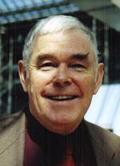|
|
(Un)Settled Science - Hole in the AGWzone Layer!
by James P. Hogan
|
|
January 14, 2010
|
|
|
When beliefs that are normally regarded as the province of science become subject to an ideology that decides in advance what answers are required and censors the evidence in ways that steer beliefs toward them, then, regardless of what incidental use might be made of computers, satellites, and other kinds of advanced engineering and technology, what's going on isn't science. But most of the world has never learned to tell the difference – or maybe cared that much.
And that's serious in a society where scientists have come to occupy the position previously enjoyed by the high priesthood, of being revered as the source of true knowledge and providing the justifications for the policies that the governing authority pursues. The danger is that pronouncements made in the name of science will continue to be unquestioned and used as pretexts for controversial or oppressive rulings long after any grounds on a scientific basis have ceased to exist.
I'm writing this at Christmas time, 2009. We've just witnessed a circus of deception and foolishness in Copenhagen that marks a new high in the attempted foisting of a politically motivated ideology upon the world in the guise of bogus science. Fortunately – for the time being at any rate – the canniness of the developing nations in demanding that the supposedly rational West literally put its money where its mouth was by playing out a lemming-like stampede to economic self-destruction brought home the absurdity to a degree that even our scientifically clueless best and brightest couldn't buy, and the whole thing largely came to nothing.
Claims that human activity was – or was even capable of – measurably affecting the Earth's climate made little sense to begin with. For as far back as patterns can be reconstructed, the climate has always cycled between being warmer or cooler, wetter or drier, stormy or settled, and the changes observed during the industrial era have been well inside the swings that have taken place in the past. So there's no reason to suppose that anything, human-induced or otherwise, is affecting the climate abnormally. Compared to water vapor and the activity of the Sun, carbon dioxide plays a minor role in determining temperature, and the amount generated by Nature dwarfs anything that humans add. In any case, the times of rising temperature recorded over the ages have all happened first, not the other way around, so increases in CO2 levels are a consequence not a cause. And even if humans were having the influence that has been claimed, the results would be overwhelmingly beneficial. Living things thrive in warmer environments, not frigid ones. Far more people die in winter from the effects of cold than from heat waves. Carbon dioxide is plant food, the basis of all life. Crops and flora of every kind grow more luxuriantly with a richer supply of it. The big advances in human civilization, reflected in the rise of cultures and times of elevated expansion and exploration, inventiveness, agriculture, artistry, and science, all occurred in warmer climatic periods. Anyone who is sincere about praising the virtues of a "green" planet should love it.
Shortly before Copenhagen, the suspicions that even superficial consideration of such points should have raised were confirmed beyond doubt with the revelations of collusion, going back years, among a cadre of climate researchers to manufacture a scientific case supporting a quasi-religious world view and presumption of the relationship between man and nature that is being given as the justification for measures that would impose drastic energy cutbacks and costly changes in living standards worldwide. The practices employed include massaging and falsification of data; suppression and destruction of conflicting evidence; rigging of computer models to deliver predetermined results; withholding of information from independent examination; the exclusion of dissenters from the official peer review process; and the intimidation of journals from publishing their objections. For those who may have missed the controversy going on behind the scenes while the mainstream media are apparently doing their best to play it down, or have just returned from a vacation on Mars, a good overview by Paul Driessen is posted here. But a couple of examples will give the idea:
|
|
|
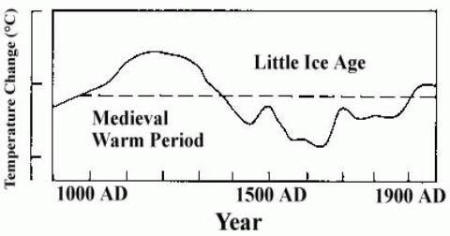
[Click to enlarge]
|
|
|
The figure above was published by the Intergovernmental Panel on Climate Change (IPCC) in its 1990 maiden assessment and shows the pattern of variation in the Earth's temperature over the previous thousand years that had been generally accepted up until then, based on data from such sources as tree-rings, lake sediments, ice cores, and historic documents. It clearly depicts the "Medieval Warm Period" (MWP) of 900–1300 AD, when the Vikings maintained settlements and farms on the green coasts of Greenland and wine grapes grew in Scotland, and the "Little Ice Age" (LIA) that followed, centered on 1600 AD, in which winter fairs were held on London's frozen River Thames, and R. D. Blackmore's novel Lorna Doone had trees on Dartmoor bursting with sounds like cannon shots under the pressure of internal ice. These periods are part of a series of natural cycles that go to greater extremes, such as one around six thousand years ago, when the Sahara was grassland watered by rivers, and southern England basked in subtropical luxuriance. (Humans and polar bears survived just fine.)
Ever since humans began turning applied intelligence in the form of technology to making life more secure, comfortable, and generally less burdensome, there has been a pervasive element among them who took it upon themselves to oppose and condemn what most were inclined to view as a bettering of their condition. There seems to be something akin to a religious guilt complex at work, in which the seeking of creature comforts and a reprieve from toil and drudgery is seen as sinful, and atonement calls for renouncing the benefits and returning to the rigors of a simpler but more virtuous, soul-cleansing life. (It's interesting to note that the guilt tends to be expressed primarily by the more affluent, articulate, and influential, whose own standards will be little affected by the sacrifices demanded of those who are supposed to do the atoning.)
Things reached a crescendo in the later decades of the twentieth century, when soaring productivity and such revolutionary innovations as affordable air travel and communications for the masses, and the prospect of unlimited energy threatened wanton iniquity exploding on a worldwide scale. Reactions from the righteous came swiftly with the campaigns to demonize DDT, pesticides, fertilizers, chemicals, and nuclear energy, and apocalyptic auguries of planetary destruction from exhaustion of the food supply (late 1960s); a carbon-burning-induced ice age (mid 1970s); jetliner exhausts, particularly the SST (late 1970s); depletion of the ozone layer (1980s). But of all the environmental alarms that were sounded and had their day, the banner issue to emerge, behind which all the disparate cohorts of doom and ruin rallied, was global warming.
For anyone with stakes in the manmade disaster business, it had everything going for it: lurid images of polar meltdown, drowning cities, and dried-up farmland; a threat of global dimensions that demanded coordinated global action, and hence the institution of a global policing authority that had long been the dream of those who would abolish sovereign nation states; limitless opportunities for tax-funded "further research" and worthy political causes; and all the usual suspects to blame for opponents of industrial civilization and the Western way of life in general. Frustrated academics and intellectuals with cravings for recognition but nothing to offer that anyone would vote for at the ballot box or freely spend their money on in the market place could become voices behind the throne and make the world notice them. Even the villains of the piece had something to gain with the promise of enormous subsidies and tax incentives in return for diverting their efforts into environmentally friendly projects and "alternative" energy sources that had the one common attribute of being utterly incapable of supplying the needs of an advanced, technology-driven society, and likely to price energy – and hence just about everything else – beyond the means of most people in all but approved and rationed amounts.
Moreover, a believable mechanism by which man's nefarious actions, if left uncurbed, might heat the planet to the verge of spontaneous combustion was right there. All major industries and large-scale transportation systems depend ultimately on fuel burning, with the consequent release of carbon dioxide (apart from nuclear, but that had effectively been put on hold for the time being). Carbon dioxide contributes to the "greenhouse effect," the natural process by which the atmosphere keeps the Earth around 33°C warmer – and therefore inhabitable – than it would otherwise be at this distance from the Sun. Provided one didn't look too closely at the numbers, which showed things like CO2 being a minor greenhouse gas compared to water vapor, and the bulk of it coming from natural sources such as oceanic outgassing, volcanic activity, and the byproducts of life and decomposition, CO2 could be presented as the principal mover, and human activity as the agency primarily responsible for generating it. In an age conditioned to accepting anything that comes out of a computer with uncritical awe and bedazzlement – Garbage In, Gospel Out – the next best thing to a infallible papal pronouncement on the veracity of the theory as an article of faith could be produced in the form of complex computer models with the appropriate assumptions and outcome built-in.
It was the perfect formula. A universal gravy train. The Great Social Equalizer – although some would remain more equal than others. The road to power of truly totalitarian dimensions. . . .
There was only one small thing wrong. The record of temperatures past said that the Earth had already been through variations greater than anything that could be coaxed out of CO2-driven computer models while humans were still depending on sailing ships and water wheels, and nothing remarkable had come of it.
In an article that appeared recently in American Thinker, Marc Sheppard describes the astonishment, in 1995, of a geophysicist at the University of Oklahoma on receiving an e-mail from a leading figure in climate change research that said, “We have to get rid of the Medieval Warm Period.” And they did.
|
|
|
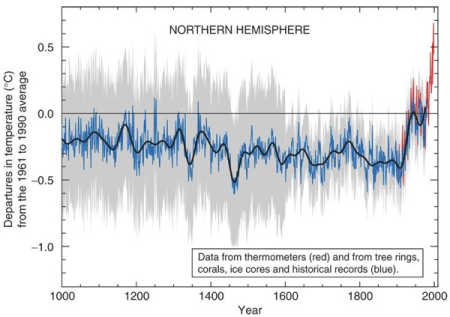
[Click to enlarge]
|
|
|
This is the version of the temperature record that appears in the IPCC's 2001 Assessment, and is particularly stressed in the Summary for Policymakers, the highly-politicized synopsis that is all that most of the people making decisions that affect the lives of millions read, and which commands the bulk of media attention. It's the curve that has come to be known as the "Hockey Stick," from its shape of temperatures fluctuating about a fairly level mean implicitly for millennia, and turning upward sharply around the beginning of the twentieth century to mark the commencement of an unprecedented increase coincident with the growth of human population and industrialization. The construction merges data from a number of sources, applying certain statistical procedures – which in itself is not unusual when normalizing large data sets – and subjecting the result to various "corrections," said to compensate for biases and drifts.
Challenges from skeptics followed immediately on grounds of both the validity of the data used and the methodology employed. Since reliable and systematic temperature measurements are not available from before about 1850, "proxy" figures were used instead for the earlier portion, calculated from such sources as analysis of tree rings and lake-bottom sediments, while actual thermometer figures were used for the more recent period. But tree rings are affected by rainfall, humidity, diseases, and other factors, and teasing out the effect attributable to temperature is controversial. Critics contended that the results as presented made the earlier period appear cooler than it was, while the later part did the opposite – all of which, of course, would suit a predetermined agenda for demonstrating recent warming quite well.
The objection to the later thermometer measurements was that they turned out to be based essentially on figures from ground stations, which independent surveys have revealed as being poorly sited to an astonishing degree in locations guaranteed to read high, with nearby air-conditioner outlets, large expanses of concrete and asphalt, parked vehicles, and the like. In many cases the surroundings have changed with time, so that what the temperature increases recorded over the years and duly fed into the statistical surveys were in fact measuring was local urban development and the expansion of airports, not changes in the climate. The more rural the ground stations, the less the effect. Measurements from satellites and balloons, by contrast, showed no consistent warming trend.
A basic principle of science is openness, which requires data and methods to be made available to others so that results can be verified by duplicating them – or else falsified. The authors of the Hockey Stick refused to disclose their raw data or details of the processing methods and computer codes that they had applied. One priceless reason, given in response to a request from an Australian scientist, was, “Why should we . . . when your whole aim is to find something wrong with it?” (!) Nevertheless, a couple of Canadian researchers managed to put the story together through some intricate detective work and demonstrated that the model was rigged to produce a hockey-stick shape – even if fed random data or telephone numbers.
Things didn't end there, unsurprisingly. Defenders closed ranks to uphold the warming thesis and contest the refutation, and the controversy continues heatedly at present, but you'd never know it from following the mainstream media or listening to inane assertions that "the science is settled." Many in the alarmist camp are reported to be having second thoughts, but the diehards argue that, while the original hockey stick derivation may have had its flaws, other bodies of evidence show that the trend is real nevertheless. An example that continues to be cited in papers published by major science journals is a collection of tree ring measurements from Siberia that in fact formed one of the data sets incorporated into the initial study. However, when skeptics finally obtained the original data after encountering strenuous efforts to withhold them, they found that the sample used consisted of just 12 trees selected from a set of 252 – which included 34 from the same geographical vicinity as the selected 12. The illustration below shows how much difference the selecting – known as "cherry picking" – made.
|
|
|
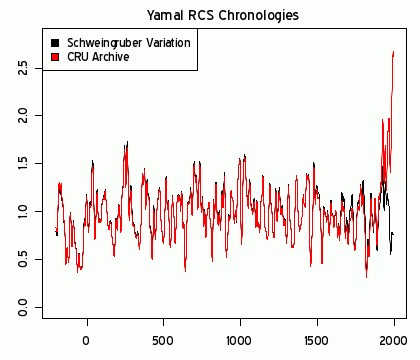
[Click to enlarge]
|
|
|
|
The red line is the result obtained with data from just the 12 selected trees – the picture the world is given as proof that we're melting the Antarctic ice cap. (Even if it were true, how a rise of 2.5°C is supposed to melt billions of tons of ice covering an area one and a half times the size of the United States, in places extending as deep as 16,000 feet, at an average temperature of -60°C, is never explained.) The black line shows what happens when the same procedure is applied to the full data set of all 252 trees. No comment necessary.
|
|
|
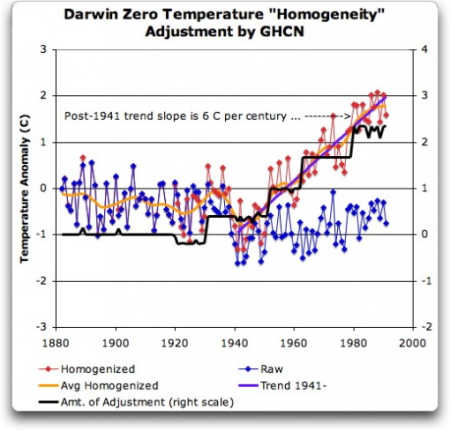
[Click to enlarge]
|
|
|
Here's another example, this time from a station at Darwin in Northern Australia. The red line shows the huge warming reported after "adjustments" to the original data that as far as I can ascertain have never been clearly accounted for. The unadjusted data, shown in blue, once again actually exhibits cooling. Taken from Anthony Watts's site, which also provides a detailed discussion. James Delingpole of the UK Telegraph gives further examples of similar cases around the world and shows how data from areas that show no warming, or even actual cooling, have been dropped and replaced by extrapolations from surrounding regions, sometimes at considerable distances away, to produce an impression of net overall warming. In summary, there appears to be substantial evidence, from a number of independent sources, that the data used for the IPCC's conclusions have been adjusted in undocumented ways, and those adjustments account for practically all the warming we are told has been caused by humans.
So what effect, if any, have humans really had? The doctrine reflected in the IPCC's position is that temperatures have risen through the twentieth century, the prime cause is carbon dioxide produced by humans, and if left to continue, the result will be planetary disaster. There is little dispute that carbon dioxide levels have increased. Whether this can unequivocally be attributed to humans in the way that is usually assumed, however, is another question. Studies of ice cores show that in the natural cycle of things, temperature rises come first by anything from decades to centuries, so much of the increase in CO2 could well be an effect of recovery from the Little Ice Age. This is supported by the fact that most of the warming that did take place in the 20th century – around 0.6°C – took place before 1940, whereas CO2 didn't really take off until the postwar growth of industrialization, so it's difficult to see how the latter could have caused the former. Reports are available from the times before the issue became a political matter subject to Orwellian rewrite, and independent studies have been conducted based on all the data available today without the unexplained adjustments. What they show is:
-
Warming from around 1920 to the early 1940s. (NASA has admitted that 1934 was the US's warmest year, not 1998 as recently hyped, and that three of the warmest years were before 1940. Said to be due to a "mathematical error.")
-
Cooling from after 1940 to the late 1970s. (Most people today will have forgotten, or maybe never knew, that this was when the same science journals and news sources were warning of an end to life as we know it with the imminent onset of a new ice age. The culprit was fossil-fuel burning, the means this time being particulates in the atmosphere cutting down incoming sunlight. The solution was the ending of life as we know it by the same kind of taxes, cutbacks, and global policing as are being called for today.)
-
Warming from the late 1970s to about 1998
-
No change from 1998 to 2001, and net cooling since then which pretty much negates the warming experienced in the first part of the century.
Hence, the only period for which both CO2 and temperature happened to be rising together is the twenty-odd years from the late seventies to the late nineties. As far as any evidence goes, this is the entire case for manmade global warming and all the panic that has ensued because of it.
We are told that consensus among the world's scientists has put the subject beyond further debate. But something that the mainstream media have been largely silent about is that more than 4,000 scientists, including 72 Nobel Prize winners, from 106 countries, have signed an appeal addressed to the world's leaders expressing grave reservations and calling for policymaking to be founded on scientific criteria and not on irrational preconceptions. “The greatest evils which stalk our Earth,” they state, “are ignorance and oppression, and not Science, Technology, and Industry, whose instruments, when adequately managed, are indispensable tools of a future shaped by Humanity, by itself and for itself.” If consensus is to be the measure, then that's three times the number of experts cited by the UN IPCC; and even these turn out to be mostly political representatives or graduates in the humanities, with no training in the philosophy or methods of science.
Over 34,000 scientists have signed a petition saying there is no convincing evidence that gases released through human activity pose any threat to the future.
Nevertheless, with eyes and minds fixated on political and ideological goals, and all faculties that might connect with reality apparently on hold, the coterie who would dictate the world's future met with the intent of agreeing an agenda that would send energy usage and living standards back to levels appropriate to the nineteenth century, while four inches of snow fell outside, and unprecedented early blizzards were blanketing Europe and setting records in the American Midwest. This at the end of a year that has seen China's coldest winter in 100 years, Baghdad having its first snow in recorded history, record levels of Antarctic sea ice, and record cold in Minnesota, Texas, Florida, Mexico, Australia, Iran, Greece, South Africa, Greenland, Argentina, and Chile.
But such inconvenient truths as facts don't matter when you're pushing an ideology, either because it's what will bring big breaks your way or because you genuinely believe you're saving the planet. The great fear underlying it all is the neo-Malthusian specter of overpopulating a world with limited resources and going downhill in an orgy of Mad Max degeneracy and desperation when everything finally runs out. That's a legitimate view to hold. And it might even be correct. But it's a social and political issue that should be honestly addressed and argued as such. Trying to justify a preconceived dogma through phony, trumped-up science isn't the way to go. The fraud will eventually be exposed, and the main victim will be trust in real science of every kind – both of which are already happening.
I've written previously on why I believe the fears to be misplaced. Applying observations drawn from the population dynamics of animals to human societies is to deny the qualities which set humans apart. Unlike animals, who simply consume resources and react with fixed behaviors to their environment, humans create resources and change their behavior according to the new conditions that they bring about. A resource isn't a resource until the knowledge and the means exist to make use of it. New technologies create new resources, and as the record of history shows, always on a scale that dwarfs what went before. Furthermore, ample evidence exists to show that when human societies reach sufficiently high levels of affluence and well-being, birth rates decline and populations eventually stabilize in ways that Thomas Malthus and his intellectual descendants of present times fail, or refuse, to consider.
Humans do seem to have amazing reserves of tenacity and the ability to muddle through in spite of the odds, however, and a better world will very likely come out of it all one day. A world with the wisdom to realize that being able to enjoy the natural wonders of our planet and the universe, and at the same time take advantage of the benefits that human ingenuity and creativity make possible are not mutually exclusive. The inhabitants of that age will maybe look back on the present as a kind of Dark Age – a time when people finally figured out, in the form of science, a dependable way of distinguishing what's probably true from what probably isn't, and discovered the astounding things that technology is capable of – but then lacked the wit to apply either body of knowledge effectively to the betterment and benefit of all.
I sometimes wonder if a race of super-intelligences exists in some transcendental reality, who in spite of their godlike qualities found themselves bedeviled by the same social and political problems as ourselves, and created the cosmos as a gazillion Petri dishes in a gigantic genetic programming experiment to see if any of the life forms that emerged in it might come up with an answer that worked. I know it won't come as much comfort to those who want to believe that there's something out there that watches over us and cares, but it seems to me that such an intelligence would do things for its reasons, not what we think ought to be its reasons, and the fate of any particular species in the collection – let alone an individual lost in among it – would not be a matter of any great concern. Which means it's pretty much up to us, doesn't it?
James P. Hogan, a former digital systems engineer and computer sales executive, has been a full-time writer since 1980. He was born in London, moved to the USA for many years, and now lives in the Republic of Ireland. His web site is at www.jamesphogan.com.
Copyright © 2009 by LewRockwell.com. Permission to reprint in whole or in part is gladly granted, provided full credit is given.
|
|
|
Permalink to this article.
Email this article to a friend
Public comment may be made on this article on the
Thunderbolts Forum/Thunderblogs (free membership required).
|
|
|
|
|
|
|








